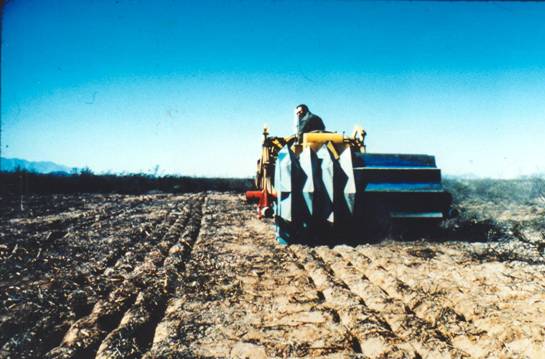
SEPTEMBER 1996 INFILTRATION PROJECT PROPOSAL
Ecological restoration and sustainable agriculture often involve replacing annual with perennial plants to control erosion and advance the secondary plant succession. For economic reasons, large scale projects almost always involve direct seeding. Seeding imprinters produce better seedbeds and seedling cradles than alternative land treatment methods for a number of reasons unique to the imprinting process. Generally they give better control of rainwater at the soil surface.
Imprinters make V-shaped depressions through downward forces about Ifoot square in size and surface shape. These microwatersheds funnel resources (rainwater, seeds, spores, plant litter, & splash-eroded topsoil) together in the trough of the imprint where the resources can work in concert to germinate seeds of perennial plants and establish the resulting seedlings. Because of rainwater convergence and concentration, deep infiltration occurs beneath the troughs which are rewetted daily by capillary return flow (wicking action), thereby providing the moisture required for germination of perennial seeds. Seeds of perennials are engineered by evolution to wait until they sense the presence of deep soil moisture before germinating.
After germination, the tender young seedlings are protected from the harsh macroclimate by the steeply sloping walls of the imprint that form a relatively safe seedling cradle. By the time seedlings grow out of the imprints into the macroclimate above, their roots have deeply penetrated the moist soil below the imprint trough. Imprinted seedling cradles shield seedlings from excessive winds, sunlight, and dehydration.
Unlike perennials, the seeds of annuals will germinate all over the imprinted microwatersheds in response to a little surface moisture. Such annuals perform an important function in ecological restoration as they serve as cover, nurse and green manure plants for the perennials that will subsequently replace them. Annual grasses and forbs stabilize the imprints, thereby extending the window of opportunity for successful establishment of perennials for at least 5 years following imprinting.
The imprinting process smoothes and firms the sides of the V, thereby increasing their structural stability and resource funneling efficiency. Also the firming improves seed-soil contact and return capillary moisture flow for' daily rewetting of the seeds until germination occurs.
Seeds are imbedded all over the imprinted microwatersheds thereby providing a diversity of microsites for the variety of seeds in a typical seed mix used in ecological restoration. with each rain, some of the seed in the upper reaches of the watershed are washed into the watershed trough for a better germination opportunity. This process can continue for up to 5 years until an adequate stand of vegetation is established. Imprinting is especially effective in arid regions where precipitation is characteristically very limited and erratic.
Erosion control is important in both ecological restoration and sustainable agriculture. Imprinting is uniquely effective in both infiltration and erosion control, two hydrologic parameters that are functionally related. In fact, imprinting is based on a series of infiltration control experiments which showed that surface microroughness and surface macroporosity are the key to infiltration regulation. Imprinting efficiently manipulates these two parameters for a wide range of infiltration control - up to two orders of magnitude. Imprinters hydraulically roughen the soil surface without inverting it and without covering plant material. Standing perennial plants are mulched, but usually not killed by the imprinting teeth. The mulch stabilizes the imprints, protects the seedlings, suppresses evaporation, limits nitrogen availability and feeds soil invertebrates that increase and maintain surface macroporosity and infiltration through their burrowing activities.
Weed problems are reduced by the minimal soil disturbance of land imprinting and the resulting relatively deep infiltration. Annual weeds are favored by land treatment methods that loosen and invert the soil surface, conditions leading to surface macropore sealing, shallow infiltration, rapid oxidation of organic matter and increase in available nitrogen.
Land imprinting goes a long way toward achieving the long-held land conservation goal of holding resources in place to nourish seeds, seedlings, and mature plants, to in turn nourish the animals that live on both sides of the air-earth interface. Because imprints are closed microwatersheds, resources are held within areas of one square foot.


Prototype imprinter: Tombstone, AZ
The Imprinting Foundation
1616 E. Lind Road
Tucson, AZ 85719Close Window to Return to List
If you entered our site on this page, click on Logo below to go to the Imprinting Foundation for more Information
